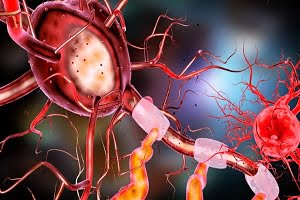Overview of Peripheral Neuropathy
- Updated on: Jul 5, 2024
- 6 min Read
- Published on Dec 26, 2020

What is Peripheral Neuropathy?
Peripheral neuropathy or peripheral polyneuropathy refers to the condition that damages the peripheral nervous system. Neuropathy causes the destruction of the nerve cells called neurons. As a result, the neurons are unable to communicate properly with each other and with the brain. Peripheral neuropathy can either affect a single nerve or a combination of nerves. For example, Bell’s palsy, in which a facial nerve gets damaged. Peripheral neuropathy involves different types of nerves, including sensory, motor, and autonomic nerves.
- Sensory nerves carry messages from sensory organs through the spinal cord to the brain.
- Motor nerves travel in the opposite direction, and they carry messages from the brain to the muscles.
- Autonomic nerves are responsible for controlling the body functions that are not in our control, such as digestion, heart rate, blood pressure, and breathing.
Peripheral neuropathy results from traumatic injuries, infections, metabolic problems, inherited causes, and exposure to different types of toxins. One of the most common causes of peripheral neuropathy is diabetes. It can lead to tingling, prickling, numbness, and muscle weakness in different parts of the body.
Different Types of Peripheral Neuropathy
Following are the different types of peripheral neuropathy:
- Mononeuropathy affects only 1 nerve
- Mononeuritis multiplex affects several nerves
- Polyneuropathy affects all the nerves in the body
Polyneuropathy is the most common type and starts by affecting the longest nerves first, so symptoms typically begin with the feet. Over time it gradually starts to affect shorter nerves and affects the hands. Polyneuropathy is caused due to various reasons, such as exposure to certain toxins, alcohol abuse, poor nutrition, vitamin deficiency (particularly vitamin B deficiency), and disease complications such as kidney failure or cancer. Diabetic peripheral neuropathy is one of the common forms of chronic polyneuropathy. It is mostly found in diabetic people who are not able to control their blood sugar levels.
How Common Is Peripheral Polyneuropathy?
Neuropathy is very common. It is estimated that about 25% to 30% of Americans are affected by neuropathy. Neuropathy occurs in 60% to 70% of people with diabetes.
Who Gets Neuropathy?
Neuropathy affects people of all age groups; however, older people are at an increased risk. It is more common in men and in Caucasians. People in certain professions, especially those who require repetitive motions, have more chances of developing compression-related neuropathy.
What Are the Problems in Peripheral Neuropathy?
Peripheral neuropathy can cause different foot problems due to pressure or injuries that can lead to blisters and sores called neuropathy feet. In diabetes, these wounds are difficult to heal and increase infection chances. Such wounds or sores in extreme cases can lead to the loss of a toe, foot, or part of the leg. Foot problems, if diagnosed early, can lower the chances of foot neuropathy. The nerve damage in diabetic people may lead to a rare condition called Charcot’s foot. It is a condition in which the bones and tissue of the foot get severely damaged.
What Are the Causes of Peripheral Neuropathy?
Following are some of the major causes of peripheral neuropathy:
- Autoimmune diseases like Sjogren’s syndrome, lupus, rheumatoid arthritis, Guillain-Barre syndrome, chronic inflammatory demyelinating polyneuropathy and vacuities.
- One of the leading causes of peripheral neuropathy is diabetes. About 60 – 70 percent of people with diabetes have mild to severe forms of peripheral nerve damage to the sensory, motor, and autonomic nerves that cause symptoms such as numb, tingling, or burning feet, one-sided bands or pain, and numbness and weakness on the trunk or pelvis.
- Different infections can attack nerve tissues and therefore result in peripheral neuropathy. Some of these infections include certain viral or bacterial infections, like Lyme disease, shingles, Epstein-Barr virus, hepatitis B and C, leprosy, diphtheria, and HIV.
- Some inherited disorders of the peripheral nerves may also result in peripheral neuropathy. One example of such disorders is Charcot-Marie-Tooth disease type 1, characterized by weakness in the legs and arms. Deformities of the feet are very common in this disorder, causing difficulty in walking, which ultimately leads to neuropathy feet.
- Bone marrow disorders involving the formation of an abnormal protein in the blood (monoclonal gammopathies), bone cancer (myeloma), lymphoma, and the rare disease amyloidosis. Other diseases which include kidney disease, liver disease, connective tissue disorders and an underactive thyroid (hypothyroidism).
- Exposure to poisons and toxic substances that include industrial chemicals and heavy metals such as lead and mercury and certain types of medications, especially those used to treat cancer (chemotherapy), can cause peripheral nerve. Different types of traumas, such as motor vehicle accidents, falls, or sports injuries, damage peripheral nerves.
- Vascular and blood problems that decrease oxygen supply to the peripheral nerves lead to nerve tissue damage. Blood vessel wall thickening and scarring from vasculitis can impede blood flow and cause patchy nerve damage. In patchy nerve damage, the isolated nerves in different areas are damaged, called mononeuropathy or multifocal mononeuropathy.
Signs and Symptoms of Peripheral Polyneuropathy
The symptoms of peripheral neuropathy depends upon the every nerve present in the peripheral nervous system because each nerve present has a specific function. Besides, the symptoms depend on the type of nerves affected and the type and severity of the damage. They can range from mild to disabling and are rarely life-threatening, and may develop over days, weeks, or years. Following are some of the symptoms associated with peripheral neuropathy:
- Numbness, prickling or tingling in feet or hands
- Sharp, throbbing, jabbing, or burning pain
- Muscle weakness
- Paralysis if motor nerves are affected
- Heat intolerance
- Excessive sweating
- Bowel or bladder problems
- Changes in blood pressure that may cause dizziness or lightheadedness
- Extreme pain in feet, legs, hands, and arms, even when they are touched lightly
- Changes in walking
- Loss of balance
- Loss of muscle tone
- Pain while walking
- Problems sensing movement or position
- Swollen feet
- Problems with urination
- Sexual dysfunction
- Diarrhea
- Weight loss (unintentional)
- Dizziness when standing up or fainting
- Nausea or vomiting
- Problems with digestion
- Muscle twitching
- Cramps
- Spasms
- Loss of muscle control
- Loss of dexterity
- Falling
- Inability to move
Risk Factors for Peripheral Neuropathy
- Diabetes (sugar levels are poorly controlled)
- Alcohol abuse
- Vitamin deficiencies, particularly vitamin B
- Autoimmune diseases which include rheumatoid arthritis and lupus
- Kidney, liver and thyroid disorders
- Exposure to certain types of toxins
- Repetitive motion which is performed for certain jobs
- Family history of neuropathy
- Infections, such as shingles, Epstein-Barr virus, Lyme disease, hepatitis B and C, and HIV
How is Peripheral Neuropathy Diagnosed?
Diagnosis of Peripheral Neuropathy requires a physical exam, which includes blood tests and a full medical history including symptoms, lifestyle, exposure to toxins, drinking habits, and a family history of nervous system (neurological) disorders. Neurological examination of tendon reflexes, muscle strength and tone, ability to feel certain sensations, and posture.
Blood Tests
This test is used to detect vitamin deficiencies, diabetes, abnormal immune function, and other indications of conditions that can cause peripheral neuropathy.
Electromyography (EMG)
Electromyography (EMG) records are used to see the electrical activity in muscles and detect nerve damage.
Other Nerve Function Tests
These tests include an autonomic reflex screen that records how the autonomic nerve fibers work, a sweat test that measures the body’s ability to sweat, and sensory tests that record the feeling of touch, vibration, cooling, and heat.
Imaging Tests
CT or MRI scans are used to look for herniated disks, tumors, or other abnormalities.
Nerve Function Tests
Nerve Biopsy
In this test, a small portion of the nerve, usually a sensory nerve, is removed to look for abnormalities.
Skin Biopsy
This test involves removing a small portion of skin to look for a reduction in nerve endings.
Treatment of Peripheral Neuropathy
Early treatments prevent the onset of peripheral Neuropathy. The main aim of treatment is based on treating the underlying disorder.
Drug Treatment
Non-steroidal anti-inflammatory drugs or other pain killers can be very helpful in controlling moderate pain. In addition to treating pain, physiotherapy is needed in improving muscle strength. Other medications like Antidepressants, Anti-seizure medications, and topical treatments are also used in treating Peripheral Neuropathy.
Lifestyle and Home Remedies
In diabetes, taking care of feet, wearing soft, loose cotton socks and padded shoes, and checking daily for blisters, cuts, or calluses is very important as it may cause neuropathy feet.
Exercise: walking three times a week regularly reduces neuropathy pain, improves muscle strength, and also controls blood sugar levels.
Quit Smoking: Cigarette smoking can affect circulation, which increases the risk of foot problems and other complications.
Eat Healthy Meals: Good nutrition is important, which contains all essential vitamins and minerals, which include fruits, vegetables, whole grains, and protein in the diet.
Avoid Excessive Alcohol: Alcohol can lead to worsening of peripheral neuropathy.
Monitoring Sugar Levels: Monitoring blood glucose levels in diabetes will help keep blood glucose levels under control and improve diabetic peripheral Neuropathy.
How to Prevent Neuropathy?
Neuropathy is only preventable when the underlying condition or cause is alsopreventable. For those who have diabetes, the long-term control of blood glucose levels is very important in avoiding neuropathy, and other complications related to diabetes. Peripheral Neuropathy that arise because of poor nutrition, alcohol abuse is preventable if the underlying causes are eliminated. However, inherited or genetic causes of neuropathy are not preventable.
What Is the Prognosis for Neuropathy?
The outlook for the nerve damage depends upon its cause. If the underlying medical conditions are effectively treated with medicine or surgery, and there is no severe damage, the prognosis can be excellent or very good. Nerves that have been affected by neuropathy take time to recover, even when the cause is treated appropriately. In other genetic conditions, there may be no effective treatment. Severe nerve damage from any cause is not reversible.












